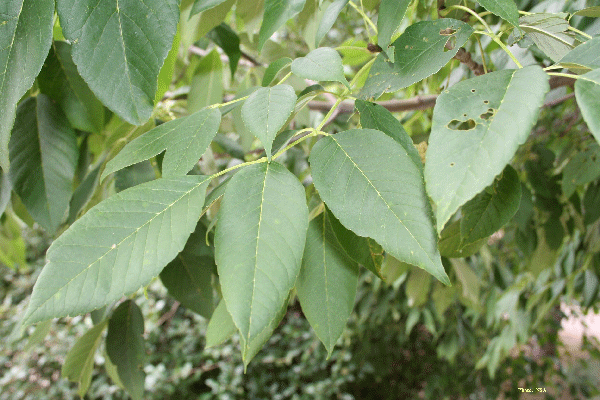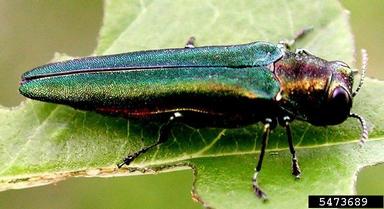With the discovery of emerald ash borer (EAB) in Omaha, some confusion over treatments has arisen. Here are clarifications on some commonly asked questions and issues.
"Has EAB been found in other areas of Nebraska?"
As of June 13, 2016, EAB has been confirmed only in southeast Nebraska. It is possible that EAB is present elsewhere in the state but has not been detected.
There are other types of borers that attack ash, particularly trees that are under stress or in decline. The 2012 drought was particularly hard on ash trees and many are infested with these native borers.
"What is the 15-mile treatment consideration zone?"
Ash trees found within 15 miles of an identified EAB infestation are at higher risk for attack. Residents in a 15-mile zone may want to consider timely treatments of high-value trees in good condition. For the most recent zone, go to http://nfs.unl.edu/nebraska-eab.
Outside of this zone, trees are at a lower risk for attack, especially if they are being well cared for. Treating trees outside of the 15-mile zone provides little or no benefit to the trees, yet exposes humans and the environment to pesticides, wastes money and, in the case of trunk injections, causes unjustified tree damage.
"How do treatments work?"
Insecticides used for EAB move under the bark through the tree’s water-conducting system to leaves and branches where the insects are feeding. Two stages of the insect are targeted: the adult beetles and the young larvae.
Adult beetles typically begin to emerge and feed on leaves in mid to late May. Control of adults reduces the number of eggs that are produced.
Larvae hatch from eggs and begin tunneling under the bark in June. Young larvae are susceptible to insecticides but become tougher to kill as they grow older. Their tunnels disrupt the movement of the pesticide within the tree, causing poor control if treatments are made too late in the season.
"Is it too late to treat this year?"
For homeowner-applied soil applications, we are past the window for treatment, which is early to mid-spring depending on the insecticide used. Soil applications require several weeks for the roots to pick up the chemical and distribute it throughout the canopy of the tree. If applied now, by the time the chemical reaches the top of the tree few adult beetles will be present, and the larvae will be much more difficult to kill.
Professional trunk-injected chemicals move more quickly through the tree; however, we are still past the ideal time to treat, which is mid-May to early June. Treating now will give partial control but, as the summer progresses, control will continue to decline.
"What are the costs of treatments?"
For a 20-inch diameter tree, costs average about $100 per year for professional treatments and trees will need to be treated every 1-2 years for as long as you want to keep them alive. Homeowner-applied soil treatments cost about $50 per year and also need to be done once a year for the life of the tree. When most of the ash trees are gone and the population of EAB has dropped, it may be possible to reduce the frequency of treatments.
"What are the drawbacks to treatments?"
All treatments need to be repeated every 1-2 years for many years to come.
Trunk injections greatly reduce the chance of exposing non-target organisms to the toxic chemical and can better protect larger trees, but a major drawback is the internal damage done to the trunk. Damage occurs from the holes made in the trunk and from the pesticide itself. Several injection methods and chemicals are available, but in general, the larger the holes and the more chemical injected, the greater the damage. Accumulative damage will shorten the life of the tree, even as EAB is controlled.
Soil treatments should not be used near sources of water or in areas with flowering plants, which could transmit the chemical to bees, butterflies and other pollinators. In addition, soil treatments often do not adequately protect trees, especially those over 15 inches in trunk diameter.
"Is my tree a good candidate for treatment?"
Be very selective about the trees you treat. Prominent trees in the landscape or trees that provide shade to the home are more valuable and may be worth treating. Trees under wires or too close to sidewalks or buildings generally should be removed rather than treated.
Trees in good condition will respond better to treatments and will better handle the damage that some treatments cause. Examine your trees for thin foliage, dead branches, sucker sprouts along the trunk or major limbs, decay mushrooms, borer holes and damaged or missing bark caused by mowers or string trimmers. Trees with these problems are likely stressed or in poor health and would not be good candidates for treatment.
Contact a certified arborist to examine your tree and discuss options. Both treatments and removals are best done by a professional with the proper training and experience.
Removal costs can be high, but if your tree is in poor condition or you decide not to treat, it will eventually need to be removed. As ash trees disappear with the spread of EAB, replanting now will allow a new canopy to become established to provide the beauty, shade and economic benefits that we all enjoy from our trees today.
The Nebraska Forest Service strives to enrich lives by protecting, restoring and utilizing Nebraska's tree and forest resources. Image below from Leah Bauer, USDA Forest Service Northern Research Station, Bugwood.org.


